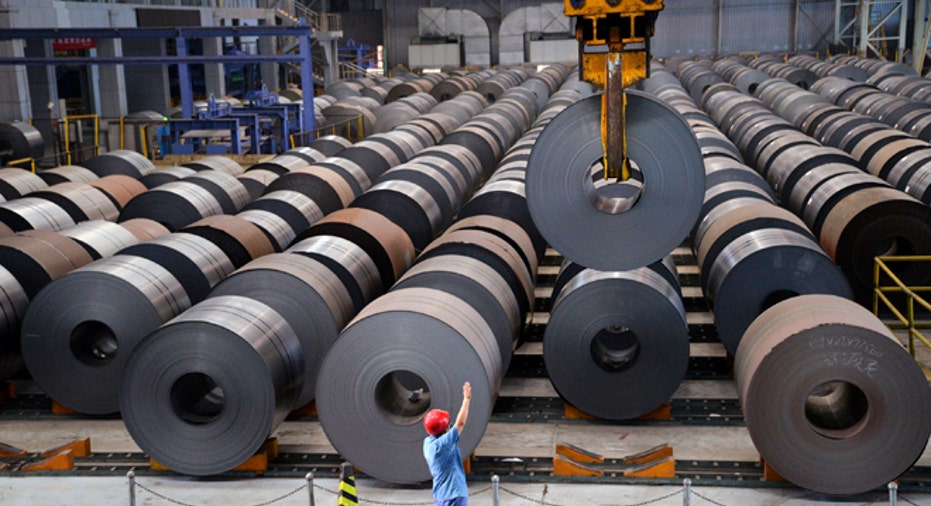Can U.S. Steel Companies Rise Above Chinese Imports?

Some believe U.S. steel companies could be in for a bit of a resurgence in the second half of 2015, although there are external factors (namely China) that could put a crimp in momentum.
Nathan Littlewood, equity analyst at Credit Suisse sees both positive and negative drivers to the steel market in 2H '15.
“On the positive side, we expect to see a very large restock cycle in the U.S. in the second half of 2015 or early 2016,” noted Littlewood.
“During the first half of 2015 we saw a large scale de-stock of customer inventories of steel, and currently depleted inventory levels are probably not sustainable on a long-term basis… At some stage customers will have to step back in the market and replenish.” he said.
One thing is for sure: how goes China, goes the steel industry.
“We are intrinsically connected one way or another with China,” stated Littlewood.
On the economic front, China announced on Wednesday that its GDP expanded 7.0% year-over-year in 2Q, beating expectations, but exactly in line with 1Q. Its economy grew 7.4% last year, slower than the 7.7% in 2013, and it will be interesting to see how the last two quarters of 2015 play out.
Chinese GDP Per Capita Growth Over Time | FindTheData!function(d,s,id){var js,fjs=d.getElementsByTagName(s)[0],p=/^https:/.test(d.location)?'https':'http';if(!d.getElementById(id)){js=d.createElement(s);js.id=id;js.src=p+"://cdn1.findthebest.com/rx/widgets.js";fjs.parentNode.insertBefore(js,fjs);}}(document,"script","ftb-widgetjs");
The number 2 economy in the world also said on Wednesday its industrial output, which measures production at factories, workshops and mines, rose 6.8% in June vs. a year ago, accelerating from May's 6.1%.
Experts primarily point to imports of steel (predominantly from China) as the primary reason for the decline in production at most major steel plants over the last several years.
“The U.S. has taken in (or imported) on average, 22%-23% of its steel, but now 34%-35% is imported, that’s an additional 12 -13 million extra tons,” Littlewood said.
“Take those imports out of the market and there’s much more demand available for the domestic players in the U.S. to sell into,” he declared.
Littlewood explained that steel mills are often very high fixed-cost businesses; when they [U.S. steel companies] produce more tons, they can dilute their cost of goods sold, which can favorably impact margins, among other things.
It makes sense that China would be the largest importer of steel. According to the The World Steel Association (worldsteel), which includes nine of the world's 10 largest steel companies, China produces nearly 50% of steel globally. But that wasn’t always the case.
“China was a slightly bigger producer of steel compared to the U.S. only 15 years ago,” according to Kevin Dempsey, Sr. VP, General Counsel, and Secretary at the American Iron and Steel Institute, but are now ‘producing 10 times that amount,’ driven by the increase in consumption in China. Interestingly, “consumption declined 3.3% in China in 2014 and that’s why imports spiked in the U.S.,” said Dempsey.
“This happened because China in effect ramped up huge amounts of capacity,” noted Dempsey; they wanted to run as high as possible, and then when domestic levels dropped, there was more focus on exports.
For some perspective on the state of the U.S. steel industry, one need only look at how their stock prices are faring. Thus far in 2015, AK Steel (NYSE:AKS), U.S. Steel (NYSE:X), Schnitzer Steel (NASDAQ:SCHN) and Nucor (NYSE:NUE), are down 49%, 31%, 22% and 11%, respectively. SPDR S&P Metals and Mining ETF (NYSE:XME) has also gotten pummeled, down 28%.
One bright spot has been Steel Dynamics (NASDAQ:STLD), which has fared much better (trading essentially flat for the year), due to its more variable cost structure, according to Littlewood.
NUE, X, STLD, SCHN & AKS Stock Performance | FindTheCompany!function(d,s,id){var js,fjs=d.getElementsByTagName(s)[0],p=/^https:/.test(d.location)?'https':'http';if(!d.getElementById(id)){js=d.createElement(s);js.id=id;js.src=p+"://cdn1.findthebest.com/rx/widgets.js";fjs.parentNode.insertBefore(js,fjs);}}(document,"script","ftb-widgetjs");
So, how can domestic steel producers improve their stance?
“Imports are coming in duty-free, we need an effective distribution system in the U.S… It’s too easy to bring in steel from around the world,” Dempsey noted.
Dempsey believes that the most important thing we can do is to make sure we have trade laws on the books and that they work effectively.
And recent legislation is likely to benefit the industry in the future.
Last month, Obama approved the Trade Preferences Extension Act, which renews trade adjustment assistance and includes new trade language for pursuing antidumping and countervailing duty investigations.
It is also widely accepted that the steel industry benefits from global growth in general. According to the International Monetary Fund, global GDP growth is expected to be around 3.5% in 2015.
“At the end of the day, the U.S. steel markets will fare much better if global growth is strong or at least above 2.5% GDP growth,” noted Littlewood.